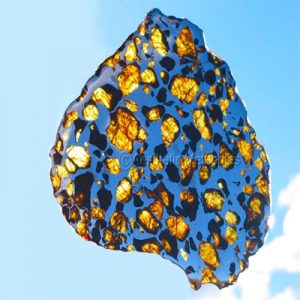Pallasite
Pallasite is a type of stony iron-nickel meteorite composed of a Kamacite (Fe, Ni) matrix interlaced with transparentOlivine (Peridot) crystals. Kamacite is a nickel-rich variety of iron that is the principal constituent of a typical octahedrite meteorite with about 92% iron and 7% nickel.
Pallasites were once thought to originate at the core-mantle boundary of differentiated asteroids which were subsequently shattered through impacts. An alternative recent hypothesis is that they are impact-generated mixtures of core and mantle materials [Edward R.D. Scott, “Impact Origins for Pallasites,” Lunar and Planetary Science XXXVII, 2007].
Pallasites are often available as polished slices or cabochons with a beautiful contrast between the bright metallic Kamacite and transparent Olivine “windows.” Pallasites are among the most beautiful (and expensive) Meteorites and can be found around the world.
Pallasites are named for the German naturalist Peter Simon Pallas (1741-1811), who located in 1772 an iron specimen with a mass of 680 kg near Krasnojarsk in the mountains of Siberia. This meteorite is known as the famous Krasnojarsk Pallasite. Kamacite is named from the Greek word “damask” meaning “shaft” or “lath” in allusion to its typical crystal pattern.
| Crystallography: | Kamacite: Isometric – Hexoctahedral |
| Crystal Habit: | Kamacite: As plates and lamellar masses and in regular intergrowth with taenite. May occur in crystals, to 30 cm; in extended plates and ribbons in Widmanstätten bands. |
| Twinning: | None |
| Cleavage: | Indistinct (Kamacite) |
| Fracture: | Hackly, Jagged (Kamacite) |
| Tenacity: | Brittle (Kamacite) |
| Hardness (Mohs): | 4.0 (Kamacite) |
| Density: | 7.90 (g/cm3) (Kamacite) |
| Luminescence: | None (Kamacite) |
| Radioactivity: | Not Radioactive (Kamacite) |
| Other: | Magnetic (Kamacite) |
| Color: | Steel Gray to Iron Black (Kamacite) |
| Transparency: | Opaque (Kamacite) |
| Luster: | Metallic (Kamacite) |
| Refractive Index: | n/a |
| Birefringence: | n/a |
| Dispersion: | n/a |
| Pleochroism: | n/a |


